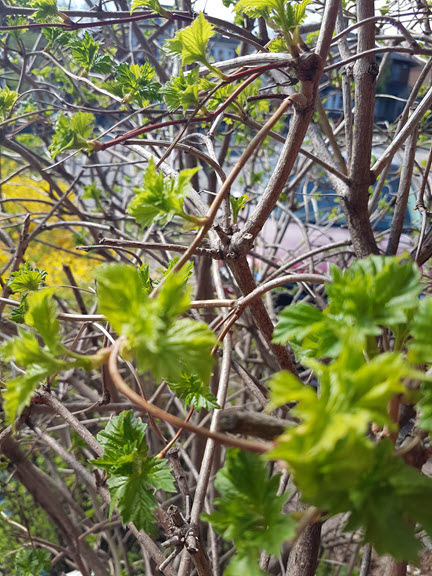
I have a bush in my front yard that I believe is a Chinese snowball bush. It has small – medium size leaves that look a bit like a maple leaves and the blooms are hydrangea like flower balls about 2 – 3 inches across (or less). Each year the leaves come out and are followed by pretty white snowball flower balls – but I also get an infestation of black regular size ants – and not just a few but a huge amount! Right now the leaves are just coming out (see attached picture) and there is no evidence of ants, eggs, a nest or other pests but I am sure to get them again if I do not do something. What can I do at this time of year to prevent the ants from coming back?
Thank you for contacting Toronto Master Gardeners about your question and also for taking an interest in preventative action to protect your Chinese Snowball bush. You have a gardener’s heart.
Let’s deal first about ways to deal with your immediate problem. By the way, not all ants are problems. Many horticulturalists encourage ants because they help break down fallen leaves into soil as they munch. You are probably aware that cosmetic pesticides are strictly regulated in Ontario so there will be no quick chemical solution, but getting at the root cause is often more interesting and healthier in the long run.
A few suggestions for now: Can you spray them with a hard jet of water? Is there an ant pathway you can identify that leads to an ant hill? Try putting some jam or syrup where they congregate and notice from where they come running. Then follow them back to the nest. Pouring boiling water on the nest works but might have to be repeated in that same location or another location where the ants relocate. Some people find spreading cornmeal discourages them. The City of Toronto permits the use of borax/boric acid and diatomaceous earth/silicone dioxide (basically fossilized flowers, finely ground ..looks like fine shards of glass under a microscope, abrasive to their underbellies causing them to dehydrate). Please speak to a reputable nursery to source these, follow instructions and protect yourself with a mask .
But the fact that your ants return annually, suggests that they may be more than an unsightly nuisance, rather indicating something about the health of your shrub that should be investigated.
First, let’s identify what kind of ant you are dealing with because your treatment for, say, carpenter ants would indicate your shrub has dead wood , hence a different treatment from an ant that is attracted to aphid excretion (“honeydew”) . To help identify your culprit, please consult one of the many on- line ant identification photo sites .
Though you do not mention any noticeable damage, it may be that you also have aphids which exude a sweet “honeydew” that attracts ants. Below is a link to the City of Toronto insect problem- solving site. It mentions spraying with a hard jet of water, applying dormant oil in spring before buds bloom, insecticidal soap, using a sticky band around the base of the tree to keep ants off and encouraging beneficial insects that feed on aphids. Again, please consult a reputable nursery to source these solutions and follow instructions .https://www.toronto.ca/services-payments/water-environment/trees/forest-management/threats-to-trees-insects/
For long-term health, consider pruning dead wood and crossed branches out of your shrub to create good internal air circulation and perhaps have fun researching companion plants and growing plants that encourage birds and other beneficial insects that would help control aphids (if you have them) and ants . Just in case it makes a difference after we investigate all this, know that a Chinese Snowball bush is in the Viburnum family all of which are lovely but susceptible to insects. Happy to hear from you again, if you decide you have another kind of infestation . Good luck with this ..hope this helps
04/16/ 23

